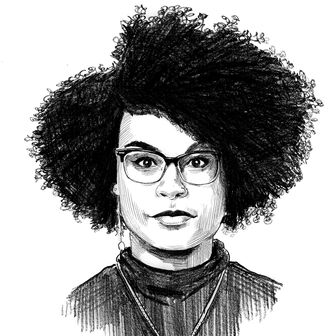
Sharp Objects is, in a word, bruising. The Gillian Flynn–based and Jean Marc-Vallée–helmed series doesn’t have the hard-bitten noir manner I expected. It’s something more beguiling instead, like the dark turn from some lost fairy tale. But the damsels and villains aren’t so easy to parse out.
“Vanish” begins with what seems, at first, to be a hazy childhood memory. Sisters Marian (Lulu Wilson) and Camille Preaker (Sophia Lillis) lazily roller skate around their small town of Wind Gap, Missouri, finding joy in the smallest of pleasures. Feeling the wind against them as they race down an empty road. Sneaking past their mother, Adora (Patricia Clarkson) — nestled, out of focus in the corner of the frame — as they make their way back into the house, book bags agape and eyes wide. But as the opening continues, it feels less like a memory awash with the glow of nostalgia and more like an omen.
Young Camille and Marian push open a door not to find their lovingly cared for bedrooms, but Camille as an adult (played by Amy Adams) sleeping in her own. This isn’t a memory; it’s a dream. It ends on a curious note, which comes to neatly encapsulate the thrust of the series: Young Camille unfurls an ordinary paper clip into a weapon that she pricks her sleeping adult self with. This is terrain in which every moment holds either the potential or promise of violence.
Camille, as an adult, is utterly transformed from the smiling, somewhat tomboyish girl we have seen in her dream. Her apartment is cluttered and disorganized. She works at a forgettable newspaper in St. Louis. Everywhere she goes, she carries the noise of clinking bottles and downs enough alcohol during the day to put down a rhino. Basically, she’s a glorious and aching mess of a woman. Amy Adams lends her a dry wit and hard gaze. When Camille navigates Wind Gap later in the episode getting all manner of reactions — some welcoming, most incredulous and wary — her physicality presents a contradiction: Here’s a woman who wants to disappear and leave people wounded in her wake. We don’t get to see much of Camille’s life in St. Louis before her avuncular editor, Frank Curry (Miguel Sandoval), sends her back to her hometown to cover a story involving the possible link between a missing teenage girl and a murdered one. But there is a brief scene in Frank’s office that gives insight into what ails Camille.
When Frank asks Camille about Wind Gap, she rattles off the kind of banal facts anyone could find with a quick search. Its population has held at 2,000 people. It’s “spitting distance from Tennessee” — making it more southern influenced than midwestern, which becomes achingly clear when she returns. Then comes my favorite exchange in the episode: “You’ve got your old money and your trash,” Camille states. “Which are you?” Frank asks. Without missing a beat, Camille puts it bluntly, “Trash from old money.”
Camille may play off this conversation with piercing wit, but it’s clear there is a wound here. If that isn’t evident, all you need to do is track her drinking. When on her way to Wind Gap, Camille stops at a dreary motel. On her bed, she dumps then organizes an array of small bottles of alcohol, Altoids, Parliament cigarettes, and junk food. It’s like an alcoholic’s travel kit. When she makes it back home, she trades this in for vodka hidden in an Evian bottle. As she delves deeper into her hometown, it becomes evident the mystery isn’t so much surrounding these girls and an untouched potential story but herself.
“Vanish” makes evident that Sharp Objects is a show dictated by memory more than anything else. As the premiere episode continues, Camille’s memories from her adolescence grow more intrusive and uncomfortable: Adora plucking her eyelashes; young Camille stumbling into a strange shed lined with meat and hard-core pornography lining the walls; her sister Marian convulsing in bed; and Marian’s wake, which sends Camille off the precipice she seems to have been dangling upon for a long time as a child.
The most canny decision showrunner Marti Noxon, who wrote “Vanish,” makes is to eschew picking apart the crimes that send Camille back home. Instead of a procedural-minded flourish, Noxon is interested in uncovering the way these crimes have affected the community of Wind Gap, which is something Camille finds difficult to navigate. There’s the disgruntled police chief, Vickery (Matt Craven), who isn’t giving up what little information he has but perks up when he realizes who Camille is. There’s the out-of-town detective with a gentle manner, Richard Willis (Chris Messina), whom Camille flirts with. (Whether she does so out of actual attraction or a desire to get information isn’t wholly clear. But, let’s be real, it’s a detective played by Chris Messina so probably both.) There’s gossipy young girls near the search party for Natalie Keene and bar patrons and family friends who always treat Camille as a curiosity, no matter how kindly they do so. “You moved away,” Vickery says as if she committed a great sin. “Vanish” is a study in the way people crash into each other in the wake of tragedy, which is never more bracing than when Camille navigates the harsh enclave of her own family.
When Adora is first introduced in the strange dream-memory of the opening sequence, she’s out of focus, a curiosity. When Camille arrives on the doorstep of her grand, beautiful home, she remains out of focus, emotionally speaking. Drink in hand, hair in gentle waves of blonde, a pink diaphanous nightgown that looks better than half my wardrobe, Adora is a tangle of contradictions. At times, she seems lost in some other world. “The house is not up for visitors, I’m afraid,” she says to Camille, as if she were a stranger, not her daughter. At another point, she grows icily blunt, reprimanding Camille for what she finds to be craven tactics of a journalist. “When you’re here, everything you do comes back on me, you understand?” Adora asks pointedly later in the episode. Camille bristles and cowers under the harsh gaze of her mother. The tension and unspoken traumas that lie between them grow even more galling when Camille’s younger half-sister, Amma (Eliza Scanlen), steps into the picture.
Amma has been on the edge of various scenes, pretending not to know Camille. (She was the obvious leader of the gossipy girls at the search party.) Outside the home in her “civvies,” Amma comes across as a specific brand of teenage hellion: aware of the power that comes from her beauty and familial standing. Inside, she’s dressed delicately and childlike. Bright bows in her hair, a dress below the knee, a dainty sweater. And she plays the part. “Vanish” is thin on plot and heavy on mood, much of which is thanks to Vallée’s style and the cinematography: natural lighting, rich colors of Wind Gap’s natural environment, cunning transitions made with sound. But in watching these three distinct women — Camille, Amma, and Adora — interact, the greatest strength of Sharp Objects comes into focus. Many recent television shows have been interested in making broad, supposedly feminist statements about women’s pain, anger, and the state of womanhood itself. In its second season, The Handmaid’s Tale is a particularly excruciating example of this trend. What makes “Vanish” so wounding is that it isn’t trying to speak about all women or make some grand statement about womanhood. It’s keener than that, choosing to understand these specific, brittle, multi-faceted women.
“Vanish” doesn’t present this story as a crime thriller that hinges on procedural mystery, or an obsession with the mind of its killer. It hinges on a place and its people. But it still ends with revelations that continue what it’s opening sequence does so beautifully: intrigue and bruise in equal measure. The first revelation is violent: the discovery of Natalie Keene’s body. When Camille hears a woman’s wailing in an alleyway off of Main Street, she and a group of town kids each connected with the victims in their own way — including Amma and Natalie’s withdrawn older brother, John — stumble onto the scene. The way Natalie’s body slumps against the building, you’d almost think her asleep if you weren’t looking too closely. But the blood on her lips and discolored limbs tell a more harrowing tale.
The second is less immediately gut-wrenching. When Camille slips into the bath — vodka, of course, in the equation — back at Adora’s home (it feels incorrect to call it her home), we see ghostly scars that riddle her body. Words etched into her skin, including the episode’s title. Some small, others blaring. Camille’s scars aren’t just emotional, they’re physical and inescapable. Seeing Camille unvarnished puts her alcoholism, the relationship to her mother’s perfectionism, and the searching quality of her memories into a different light.
In her recent memoir on her own alcoholism, The Recovering, Leslie Jamison writes, “To argue that addiction holds a mirror up to more universal hungers isn’t a denial of its physical mechanisms […] or a denial of chemical dependence as a discrete phenomenon with its own physiological reality. It’s simply an acknowledgment that the operative urges of addiction aren’t unrelated to desires that show up in everyone: the urge to court bliss, to dull pain, to find relief.” Camille is clearly filling an emptiness, numbing a hurt, blotting out some gnawing tragedy through alcohol. The way she interacts with Adora and Amma along with the scars that mark her entire body indicates the loss of Marian in her childhood is only one of them.
Wind Gap Gossip
• It’s a fleeting moment, but did Sheriff Vickery touch Natalie’s body after she was found? Doesn’t that contaminate the crime scene, or has all the time I’ve watched Law and Order: SVU taught me nothing?
• At the end of the episode, Amma — with bouncy glee — tells Camille that “now we can be sisters.” It’s meant to be sweet, but it has an undercurrent of menace.
• I’m curious to see how the show’s relationship to music develops through Camille. As we saw in Big Little Lies before this, Jean-Marc Vallée has a very particular approach to creating a soundtrack.





